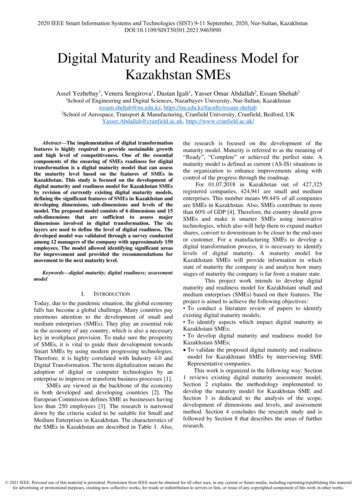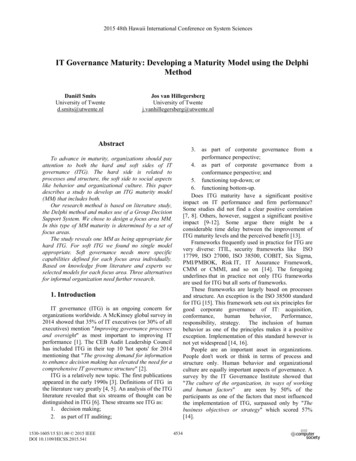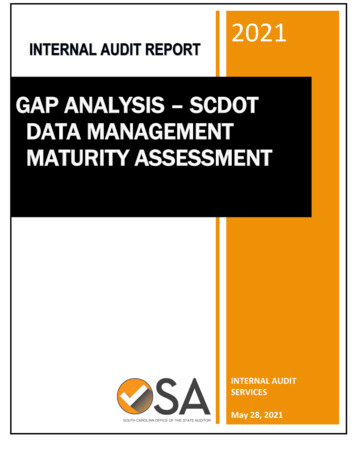
Transcription
AssessingDigital Maturity:TMThe DigiMDigital MaturityModel for HealthSystemsDamo Consulting’s DigiMTM Maturity Assessment has transformed howhealth system leaders view their progress with digital transformation. Theassessment framework has guided health system leaders in prioritizingtheir investments based on a structured and objective benchmark oftheir progress against their peer group systems. This paper describes theDigiMTM Maturity Assessment Model and how one can use it to acceleratetheir digital transformation.
2Assessing Digital Maturity: The DigiMTM Digital Maturity Model for Health Systems01Introduction02The DigiMTM Model for DigitalMaturity in health systems03Digital Maturity Assessment03.1Digital engagement: patient andprovider03.2Care management03.3Enabling technologies03.4Org model and governance04Digital Maturity – Analysis of SelectHealth Systems05How to Use the DigiMTM MaturityAssessment06Turning Insights to ActionableRoadmapsTable of Contents3
4Assessing Digital Maturity: The DigiMTM Digital Maturity Model for Health ansformation is patients’ expectations ofonline experiences at various engagementtouchpoints in accessing and receivinghealthcare services. Success with physicians, and caregivers to interact witheach other at multiple online touchpointsfacilitated by digital technology. It alsoinvolves transforming the IT infrastructureand investing in robust data managementand advanced analytics capabilities.The shift to virtual care models has alsodeep appreciation of consumer experienceforced healthcare enterprises to review theirjourneys, cross-functional collaboration toorganizational models to drive healthcareenable seamless workflows, and robustdigital transformation in the post-COVID-19technologyera.IT-enableddigital roadmaps and priorities. Healthcarecapability; however, it is not necessarilyenterprises are at varying levels of maturityIT-led. Digital transformation requires atoday in their digital transformation Damo Consulting provides a welldesigned digital transformation modelthat is used to assess organizationalstatus for digital capabilities.Model assessments allow the firmto establish effective road maps,digital strategies, and governanceframeworks.KLAS First Look Report on Damo ConsultingDownload the report
6The DigiMTM Model for Digital Maturity in Health SystemsAssessing Digital Maturity: The DigiMTM Digital Maturity Model for Health SystemsThe DigiM Modelfor Digital Maturity inHealth SystemsTMDamoConsulting’sDigiMTMDigital MaturityModel is a framework that describes the differentstages of digital maturity in the specific context ofhealth systems. The framework is supported byan online evaluation tool that scores individual02The DigiMTM framework is also a usefulThe DigiMTM Digital Maturity Model is aguide for health IT and digital health4-stage model, with Model 4 being thetechnologytheirhighest level of maturity. It is importanttarget markets and identify their targetto note that each stage in the Maturitycustomers. The demand environment forModel builds on the previous one. Tohealthcare services now favors “digital-first”illustrate the point, it would be tough forenterprises. Based on the digital maturityan entity to operate successfully in Modelscores and benchmarking analysis of the2 if the foundational EHR platform is notleading providers, health systems and theiradequately optimized to support andtechnology partners can accelerate digitalintegrate seamlessly with standalone best-transformation in the current competitivein-class digital health tools. The followingenvironment and position themselves forsection describes the DigiMTM frameworksuccess in a digital future.and the core attributes of entities in eachfirmsbenchmarks to drive incremental investmentsand roadmap execution priorities.tosegmentmaturity model stage.Damo Consulting DigiM Digital Maturity Model for Health Systemshealth systems’ digital programs and provides7Model 1: Health systems in Model 1 arefocused on maximizing the value of theirEHR investments. An example is improvingpatient access through a simple schedulingfunctionality in an EHR system. Healthsystems that embrace this model alsoprefer to rely on their EHR vendor’s productroadmap to guide their digital roadmaps.EHR as primarySTAND-ALONEDIGITALplatform for digitalINNOVATIONengagementINITIATIVES “ EHR vendor name Enterprise-specificpoint is ourdigital strategy”solutions:Homegrown andpartner-developed Focus on access functionalitiesInnovationprogramsfore.g. appointmentscheduling,commercializationof in-housereal-time video consultsdevelopment IT-led, focused on technologyenablementDigital initiatives DIGITALSTAND-ALONEfocused on expandingINNOVATIONvirtual careINITIATIVESStand-aloneSTAND-ALONEdigital healthINNOVATIONfunction Telehealth, eVisitsEnterprise-specificpointsolutions: Homegrown and “Digital front doors”partner-developed Enterprise-specificDedicated digital wnwith budget for digital healthpartner-developedprograms Patient communicationsInnovationprograms forcommercialization of in-house Extend beyond native EHRdevelopmentcapabilities for best-in-classsolutionsInnovation programs for commercializationFocused on improvedpatientof in-houseexperience and increaseddevelopmentadoption Led by IT and clinicianleadershipDIGITALINITIATIVES Enhanced use of virtual careand remote monitoring models Increased use of data andanalyticsMulti-yeartransformation strategyand investments Comprehensive, documentedtransformation roadmap Multiple strategic technologypartnerships alongside EHR,leverage startup ecosystem Advanced data and analyticsprograms, chief data officerrole Led by team of CXO’s reportingto CEOMany regional or community hospitals thatrely primarily on core EHR platforms fordigital health initiatives fall in Model 1.Model 2: Health systems in this model havecommitted themselves to virtualize theircare delivery through telehealth, remotemonitoring, and online self-service tools.The key attribute for health systems inModel 2 is that they look beyond the coreEHR platform to identify best-in-classstandalone tools for digital enablement.Model 2 health systems design onlineexperiences for healthcare consumersFigure 1: DigiMTM Digital Maturity Model for Health Systemsthat increase convenience, improve the
8The DigiMTM Model for Digital Maturity in Health SystemsAssessing Digital Maturity: The DigiMTM Digital Maturity Model for Health Systemsoverall experience, and offer multipleand infrastructure needs at the enterprisecommunicationbetweenlevel. Instead, they tend to focus more onpatients and their caregivers. In the wakeworkflow, training, and user experience toof the COVID-19 pandemic, health systemsincrease the adoption of digital health tools.channelsacross the board have invested heavily intelehealth and digital front door initiatives,often tapping into emerging technologiessuch as voice and harnessing digital healthinnovation from big tech firms and startups.Model 2 health systems tend to drive digitalinitiatives as part of an IT or telehealthprogram within the enterprise.are governed by a dedicated digital functionin Model 3 entities. The digital function maybe driven by individuals with additionalresponsibilities for other organizationalfunctions. Digital leaders in Model 3 entitiesare often practicing clinicians focusedprimarily on the enablement of onlineaccess and communication for ambulatorycare to improve utilization and broaderadoptionbypatientsandcaregivers. Internal innovation groups drivedigital initiatives in some health systems,responding to internal demand on a caseby-case basis. Digital executives inModel 3 entities typically do not haveownershipModel 4: Health systems in Model 4 arethe most mature enterprises in the DigiMTMframework. Health systems at this levelhave a comprehensive enterprise-leveldigital strategy that considers stakeholderpriorities across functions and departments.Digital transformation leaders in Model4 organizations look beyond standaloneModel 3: Digital transformation programstelehealth9for technology architecturedigital front door applications and considerdigitalizationopportunitiesacrossthefront and back end functions, includingadministrative operations. They evaluatestrategic IT enablers at the infrastructureand application levels needed to supportdigital health programs, all of which go intosecuring funding commitments for multiyear digital transformation roadmaps in linewith enterprise priorities. Health systemsin Model 4 typically commit to a handful ofstrategic technology platform partnershipsin addition to EHR. They also have structuredinternal programs to evaluate and onboardinnovative startups for driving enhancedexperiences with digital health.Using Damo Consulting’sDigiMTM maturity modelframework and assessmenttool, Prisma conducted adetailed evaluation of itsdigital maturity relative topeer health systems acrossthe nation. The assessmentprovided valuable insights tohelp drive near-term prioritiesand investment needs toaccelerate the transformationjourney at Prisma.Nick Patel, M.D.Chief Digital OfficerPrisma Health
10Digital Maturity AssesmentAssessing Digital Maturity: The DigiMTM Digital Maturity Model for Health Systems11Digital MaturityAssessmentchoice of tools for enabling patients,capabilities use the hub and spoke model toproviders and caregivers. The tools canconnect rural and urban centers to managebe native EHR features or standaloneneurological emergencies. Similarly, a Tele-platforms; often, health systems deployICU can leverage advanced centers tomultiple tools for the same functionality.communicate with physicians and nurses toThe DigiMTM Maturity Assessment tool isMaturity levels also consider whetherrather than entering them after returningthe online experiences are seamless andto the nurse station after completing theintegrated with other digital tools suchrounds.an online questionnaire tool that evaluateshealth systems based on responses toquestions covering four dimensions asdescribed below. Each answer is assigneda numerical score. There are multipleresponse choices for a question in somecases, with each option assigned a different03A well-executed digital experience strategyimproves a patient’s access to care withexperiences similar to what they arealready accustomed to in other industriessuch as banking and travel. Digital gement to avoid revenue losses dueand demand of inpatient services (liketo missed and canceled appointments.phlebotomy, respiratory therapy), transfersOne major factor that defines the successto and from inpatient units, and coordinatingdoors” enable digital patient journeys withof all digital front door applications is theircase management. Though not directlytools such as online self-scheduling, find-integration into the overall workflows ofrelated to a patient’s clinical care, Wayfindinga-doctor, chatbots, online registration andthe health system using standards such assolutions help enhance the experience ofcheck- in, and more. Digital experiencesFHIR and HL7.the patient’s family when patients in distantCaredeliverymodelsarerapidlymodel wherein the in-person experienceis complemented by virtual care modalitiessuch as remote monitoring and homehealth. Inpatient care has also evolved overthe years, with nurses and other caregiversOrg model &GovernanceEnablingTechnologiesalso use visiting their loved ones.Digitally mature health systems invest intelehealth programs for inpatient care thatimprove caregiver productivity and patientexperience and outcomes.Asaccelerates, health systems are looking atrecognition and other technologies. Tele-digital tools for routine care management.ICU and Telestroke technologies allow forRemote patient digital rounding applicationspeer- to-peer communications betweento facilitate.do not have neurologists on call available forMaturity Assessmentpatients becomes feasible. Some hospitalsambient sensing devices deploying voice-experts anywhere. Many regional centersFigure 2: Key Dimensions of DigiMsupplytaking advantage of camera-mounted andregional or community medical centers withTMthedevices, remote monitoring of cardiacCare managementtransforming to embrace a “hybrid” careCaremanagementcapacityICUs. With advanced cardiac telemetrymust include the needs of providers andDigital Engagement:Patient and Providermanagingbedflowimplementing tools such as slot utilizationevaluates health systems based on theforpatientmanagementcaregivers as well. The maturity assessmentallowasHealth systems can also improve access byscore.Digital Engagement: Patient and Providerenter orders or capture vitals at the bedsideemergency stroke management. Telestrokethevirtualizationofhealthcare
12Digital Maturity AssesmentAssessing Digital Maturity: The DigiMTM Digital Maturity Model for Health SystemsEnabling technologiesOrg model and governanceAs the adoption of telehealth and virtualAn essential factor in success with digitalcare models of health care accelerates,transformation is how a health system ishealththeset up to implement digital initiatives. TheinfrastructureDigiMTM Maturity Assessment tool considersthat will enable to scale the operations tovarious indicators such as a dedicatedmeet growing demands for netwo RemoteChief Digital Officer role, a separatelypatient monitoring (RPM) programs andallocated budget for digital initiatives, andmulti-channelcommunicationa documented approach to implementingthrough SMS/Chat/mobile are among theenterprise digital roadmaps. Some healthhigh-impact initiatives in this area. Chronicsystems are setting up digital transformationdiseasesignificantoffices (DTO) to drive enterprise-wide digitalcomponent of healthcare services. Leadingtransformation initiatives. A DTO is distincthealthcareinfrom a Chief Digital Officer role in that it isstructured programs and tools to enablea standalone function tasked with activelyremote care for patients with chronicenabling healthcare digital transformationconditions, often involving patients directlyinitiatives across the enterprise. A seniorin their care management initiatives.leader typically leads the DTO in thsignificantinfluenceMany health systems are implementingacross functions and the authority andcloud transformation programs to increaseempowerment to make critical decisionsagility, flexibility, and scalability to theirrelated to investment priorities, amongtechnology infrastructure. They are alsoother things.looking at enterprise-class platforms suchas CRM to enhance patient ing ERP platforms to automateand streamline back end processes andworkflows. Automation technologies suchas RPA are moving beyond administrativefunctions, driven by talent shortages andworkload burdens.13
Digital Maturity – Analysis of Select Health systemsAssessing Digital Maturity: The DigiMTM Digital Maturity Model for Health SystemsDigital Maturity –Analysis of SelectHealth systemsSeveral leading healthcare systems have leveragedthe DigiMTM Maturity Assessment tool to assess theirdigital maturity. The tool evaluates the relative maturityof select health systems in the U.S by assigningnumerical scores to individual digital programsimplemented by health systems. There is a significantvariation in the scores of the health systems, as is toSectionDigital Engagement14Digital InitiativeProvider 1Provider 2Provider 3Provider 4be expected. The larger health systemsmaturity level, indicating that most healthhavesystems are yet to develop or implement oundationaldata/analytics,comprehensiveapproach to transformation that positionsthem better for building seamless digital04Provider 5Provider 6experiences for consumers. Smaller healthsystems have focused more on enablingdigital front doors to address near-termpriorities. In the longer term, entities that donot invest in IT modernization and adoptingemerging technologies such as the cloudmay find themselves at a competitivedisadvantage. Very few health systemscovered in our assessment are at Model 4comprehensive transformation.There are significant differences in maturitylevels across health systems, Benchmarksfrom our database of digital assessmentacross more than 30 health syste,msindicates the variations in how each healthsystem is approaching digital engagementfor patients and providers. While manyhealth systems have implemented theirdigital experience platforms using mainlynative features in their EHR platforms,leadinghealthProvider 8Provider 9Provider 10systemshavechosento implement standalone best-in-classsolutions withProvider 715out-of-the-boxFHIR/HL7 integration capabilities. The DigiMTMmaturityassessmentenableshealthOnline schedulingsystems to benchmark their current stateChatbotagainst industry-wide benchmarks using aFind-a-docstandardized approach. It must be statedthat, the maturity assessment is not meantSymptom triageto be prescriptive. What may seem aOnline payment toolstrategic priority for one health system mayOnline registrationbe relatively unimportant for another in aOnline check-indifferent market with an entirely different setWait-time estimatorof competitive factors.Mobile appVideo visitsNot implementedImplemented with native EHR capabilityEnterprise-class platform or point solutionFigure 3: Digital Front Door Initiatives at Select Health Systems ** Source: DigiMTM Digital Maturity Assessment
16Digital Maturity – Analysis of Select Health systemsAssessing Digital Maturity: The DigiMTM Digital Maturity Model for Health SystemsHealth systems leaders, who have takenintelligence data from our DamoIntelTMthe DigiMTM Maturity Assessment Survey,platform, health system executives drivehave used the analysis to review and revisitpriorities for implementing new use cases,their investment priorities and developidentifying solution providers to partnermulti-year digital roadmaps. By using thewith, and benchmarking their progressmaturity assessment alongside competitiveagainst industry peers.The DamoIntelTM PlatformDigital healthsolutionproviderdirectoryDirectory of digitalhealth initiatives atthe top 50 healthsystems and healthplansSearchable bytechnologycategory andover 120 usecases/featuresFigure 4: DamoIntelTM Platform FeaturesStandard and customreports for rapidevaluation of solutionoptions and vendorcomparison17
18How to Use the DigiMTM Maturity AssessmentAssessing Digital Maturity: The DigiMTM Digital Maturity Model for Health Systems19How to Use theTMDigiM MaturityAssessmentHealth systems executives may use theDigiMTM Maturity Assessment in a couple ofways: Compare and benchmark their maturityrelative to competitors in their markets.Our analysis of the highly competitiveNew York City market for one of ourclients enabled them to develop ahighly focused roadmap with a clear setof near-term priorities. Engageinfurtherwhere a large majority of mid-tier healthdiscoveryandexploration to validate their ratejourneywithfocused investments and technologypartnerships. At a large regional twithexecutiveinterviews and an internal survey toidentify the most important digitalexperience priorities for the enterprise.systems exist. In these systems, digitalinvestments are guided by departmental orfunctional priorities and implemented undera CIO’s leadership. Health systems in Model3 are taking the next step towards providingthe required focus for digital initiatives byappointing a dedicated leader to the role.Organizationmodelsfordigitaltransformation are evolving. In some cases,the leader is a clinician with additionalresponsibilities; in others, it is an individualResearch and client interviews conductedwith responsibilities for marketing andby Damo Consulting suggest that therepatient communications. Many CIOs are deare very few health systems at Model 4facto digital leaders in their organizationsmaturity today. Our research indicates thattoday. However, among the more maturehalf or more of the roughly 5500 hospitals inhealth systems, the front and back end ofthe U.S. are today in Model 1. Many of thesedigital transformation is led by separatesystems are moving to Model 2, which isleaders.The DigiMTM Digital MaturityModel is a starting pointthat provides an objectiveassessment of the currentstate. Health systems willbenefit from an additionalvalidation of internalpriorities to develop aroadmap for achieving theirdigital transformation goals.Paddy PadmanabhanCEODamo Consulting Inc.
20Turning Insights to Actionable RoadmapsAssessing Digital Maturity: The DigiMTM Digital Maturity Model for Health SystemsTurning Insights toActionableRoadmapsThe DigiMTMDigital Maturity Model is a startingpoint for a careful benchmarking of a healthsystem in its competitive landscape and againstthe industry’s overall state. The scoring ranges,and the detailed commentary accompanyingthe scores, provide individual data points fromwhich the health system can help reprioritizeinvestments and accelerate progress.maturity assessment scores into actionableindustry peers at the level of individualinputs and will achieve the following:digital health programs.1.06The DigiMTM Maturity Assessment toolSince the scores are based on self-emphasizes the importance of onlineassessment, health systems leaders willaccess or digital front doors in a healthbenefit from an additional level of validationsystem’s digital transformation roadmap,that explores the degree of progressa high priority area of focus today. Healthwith individual initiatives and comparessystems leaders can use the assessmentit with the progress made by other healthscores to identify gaps in their roadmapssystems. Damo Consulting offers a 6–8-and prioritize/reprioritize investments asweek consulting offering that can turn theValidate self-assessment based on4. Develop competitive intelligence anddetailed benchmark data and furtheruse it to drive investment priorities andevaluation of ongoing initiatives.partner selection.2. Discover organizational needs with5. Identify key technology partnershipsinternal surveys, focus groups, andto achieve digital objectives using our1:1 leadership interviews to identifyone-of-a-kind DamoIntelTM databasepriorities and dependencies.of digital health initiatives across health3. Benchmark the DigiMTM score againstsystemsandtechnologyValidate self-assessmentbased on detailedbenchmark data andfurther evaluation ofongoing initiatives.Discover organizationalneeds with internalsurveys, focus groups,and 1:1 leadershipinterviews to identifypriorities anddependencies.partners,enabling the programs.Damo Consulting has vast expertise in developing digital roadmaps for some of the nation’slargest health systems. We have helped health systems direct hundreds of millions of dollarsin digital health investments using a structured playbook for digital transformation. Ourapproach has saved tens of millions of dollars, helped digital leaders make the right partnerdecisions, and accelerate their transformation journeys.Take the DigiMTM Digital Maturity Assessmentnecessary.Turning insightsinto action a 5-step process 21Benchmark the DigiMTMscore against industrypeers at the level ofindividual digital healthprogramsDevelop competitiveintelligence and use itto drive investmentpriorities and partnerselectionIdentify key technologypartnerships to achievedigital objectives usingour one-of-a-kindDamoIntelTM database ofdigital health initiativesacross health systemsand technologypartners, enablingthe programs
info@damoconsulting.netwww.damoconsulting.netTo receive weekly updates on industrydevelopments and our latest content launches,subscribe to our weekly newsletter.Damo Consulting provides digital transformation advisory services to enablehealthcare organizations navigate the technology-enabled transition to telehealthand virtual care. We bring deep industry knowledge, market insights and technologyskills to help develop and implement enterprise digital roadmaps. We work withhealthcare IT and digital health firms to develop and execute market growth strategies.
The DigiMTM Digital Maturity Model is a 4-stage model, with Model 4 being the highest level of maturity. It is important to note that each stage in the Maturity Model builds on the previous one. To illustrate the point, it would be tough for an entity to operate successfully in Model 2 if the foundational EHR platform is not










